Hello, my name is Brianna Vasquez and I am a sophomore, majoring in hospitality management at New York City College of Technology. I am in love with all subjects pertaining to food and its innovations that are trending in the culinary world since I aspire to become a pastry chef. But I wanted to share easy gourmet dishes that can be made from the items you most likely already have at home in the fridge or pantry. I am overly obsessed with molecular gastronomy which is a food practice that applies scientific principles to the improvement of food by different techniques and ingredients. It can affect the texture, color, shape, and flavor of the food item. Molecular gastronomy has gotten so popular that it now provides kits for professional chefs and home cooks to use which can be expensive ranging from $30-$350 depending on what is offered in each kit. It is an expensive practice due to the gourmet ingredients used like xanthan gum that is not readily available in local supermarkets. Nevertheless, I wanted to share an inexpensive recipe for molecular gastronomy spherification which is commonly used as a garnish that can allow you to feel like a Michelin star chef in quality without spending a lot of cash.
Here’s the Recipe for Gelatin “Caviar”:
But first is some basic information when making gelatin caviar is
1. Choose strong flavors such a strong brewed coffee or balsamic vinegar that can be easily tasted due to their potent flavors.
2. Choose an oil whether vegetable (which is what I recommend since it is more versatile and readily available) or grape seed. Don’t use olive oil or coconut oil and other oils that can easily solidify. Since the oil must be cold in order form the caviar to solidify into its pearl-like shape. The oil can either be put in the freezer for an hour but preferably overnight to chill or be placed in an ice bath.
3. Choose what tool to drop with whether a plastic squeeze bottle (which is what I used), a culinary syringe, or an eye dropper in order to drop the liquid into the oil.

Image by ckubber via Flickr
Gelatin “Caviar”




